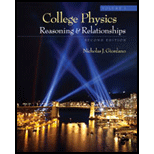
Concept explainers
(a)
The average velocity over the time interval
(a)
Answer to Problem 53P
The average velocity over the time interval
Explanation of Solution
Write the expression for average velocity.
Conclusion:
Substitute,
Therefore, the average velocity over the time interval
(b)
The average velocity over the time interval
(b)
Answer to Problem 53P
The average velocity over the time interval
Explanation of Solution
Use equation (I) to find the answer.
Conclusion:
Substitute,
Therefore, the average velocity over the time interval
(c)
The average velocity between
(c)
Answer to Problem 53P
The average velocity between
Explanation of Solution
Use equation (I) to find the answer.
Conclusion:
Substitute,
Therefore, the average velocity between
(d)
The relation of answers in part (a), (b), and (c).
(d)
Answer to Problem 53P
The relation is average of answers in part (b), and (c) is answer in part (a).
Explanation of Solution
The total average velocity over the time interval
Write the expression for the average velocity.
Conclusion:
Substitute,
Therefore, the relation is average of answers in part (b), and (c) is answer in part (a).
Want to see more full solutions like this?
Chapter 2 Solutions
COLLEGE PHYSICS,VOL.1
- (Figure 1)In each case let ww be the weight of the suspended crate full of priceless art objects. The strut is uniform and also has weight w. Find the direction of the force exerted on the strut by the pivot in the arrangement (b). Express your answer in degrees.arrow_forwardA 70.0 cm, uniform, 40.0 N shelf is supported horizontally by two vertical wires attached to the sloping ceiling (Figure 1). A very small 20.0 N tool is placed on the shelf midway between the points where the wires are attached to it. Find the tension in the left-hand wire. Express your answer with the appropriate units.arrow_forwardFind the total bind Mev. binding energy for 13 Carbon, 6C (atomic mass = 13.0033554)arrow_forward
- What is the 27 energy absorbed in this endothermic Auclear reaction 2] Al + 'n → 27 Mg + ! H? (The atom mass of "Al is 26.981539u. and that of 11 Mg is 26.984341u) MeVarrow_forwardWhat is the energy released in this nuclear reaction 1 F + "', H-1 O+ He? 19 19 16 (The atomic mass of 1F is 18.998403 u, and that of 20 is 15.9949154) MeV.arrow_forwardWhat is the energy released in this B+ nuclear reaction خالد 2½ Al w/ Mg + ie? (The atomic mass of 11 Al is 23.9999394 and that > of 12 Mg is 23.985041 u) MeV.arrow_forward
- What is the energy released / absorbed in this nuclear reaction 14 N+ & He → » O + ! N? (The atomic mass of 14 N is 14.003074u. 17N+ and that of 10 is 16.9991324). MeVarrow_forwardCan someone help me answer this question thanks.arrow_forwardCan someone help me with this question thanks.arrow_forward
- 4B. Four electrons are located on the corners of a square, one on each corner, with the sides of the square being 25 cm long. a) Draw a sketch of the scenario and use your sketch to b) Determine the total force (magnitude and direction) on one of the electrons from the other three?arrow_forwardPortfolio Problem 3. A ball is thrown vertically upwards with a speed vo from the floor of a room of height h. It hits the ceiling and then returns to the floor, from which it rebounds, managing just to hit the ceiling a second time. Assume that the coefficient of restitution between the ball and the floor, e, is equal to that between the ball and the ceiling. Compute e.arrow_forwardPortfolio Problem 4. Consider two identical springs, each with natural length and spring constant k, attached to a horizontal frame at distance 2l apart. Their free ends are attached to the same particle of mass m, which is hanging under gravity. Let z denote the vertical displacement of the particle from the hori- zontal frame, so that z < 0 when the particle is below the frame, as shown in the figure. The particle has zero horizontal velocity, so that the motion is one dimensional along z. 000000 0 eeeeee (a) Show that the total force acting on the particle is X F-mg k-2kz 1 (1. l k. (b) Find the potential energy U(x, y, z) of the system such that U x = : 0. = O when (c) The particle is pulled down until the springs are each of length 3l, and then released. Find the velocity of the particle when it crosses z = 0.arrow_forward
 Principles of Physics: A Calculus-Based TextPhysicsISBN:9781133104261Author:Raymond A. Serway, John W. JewettPublisher:Cengage Learning
Principles of Physics: A Calculus-Based TextPhysicsISBN:9781133104261Author:Raymond A. Serway, John W. JewettPublisher:Cengage Learning Physics for Scientists and Engineers: Foundations...PhysicsISBN:9781133939146Author:Katz, Debora M.Publisher:Cengage Learning
Physics for Scientists and Engineers: Foundations...PhysicsISBN:9781133939146Author:Katz, Debora M.Publisher:Cengage Learning Physics for Scientists and Engineers, Technology ...PhysicsISBN:9781305116399Author:Raymond A. Serway, John W. JewettPublisher:Cengage Learning
Physics for Scientists and Engineers, Technology ...PhysicsISBN:9781305116399Author:Raymond A. Serway, John W. JewettPublisher:Cengage Learning Physics for Scientists and Engineers with Modern ...PhysicsISBN:9781337553292Author:Raymond A. Serway, John W. JewettPublisher:Cengage Learning
Physics for Scientists and Engineers with Modern ...PhysicsISBN:9781337553292Author:Raymond A. Serway, John W. JewettPublisher:Cengage Learning An Introduction to Physical SciencePhysicsISBN:9781305079137Author:James Shipman, Jerry D. Wilson, Charles A. Higgins, Omar TorresPublisher:Cengage Learning
An Introduction to Physical SciencePhysicsISBN:9781305079137Author:James Shipman, Jerry D. Wilson, Charles A. Higgins, Omar TorresPublisher:Cengage Learning University Physics Volume 1PhysicsISBN:9781938168277Author:William Moebs, Samuel J. Ling, Jeff SannyPublisher:OpenStax - Rice University
University Physics Volume 1PhysicsISBN:9781938168277Author:William Moebs, Samuel J. Ling, Jeff SannyPublisher:OpenStax - Rice University





